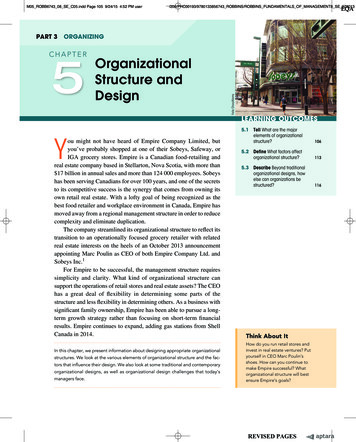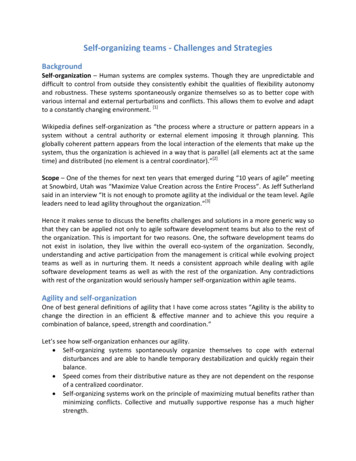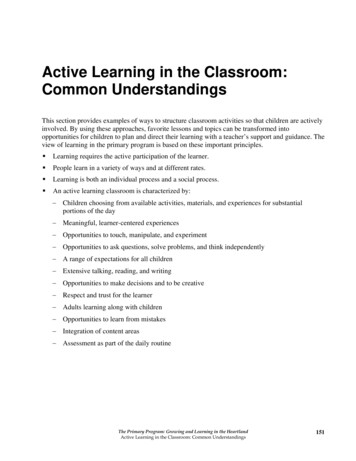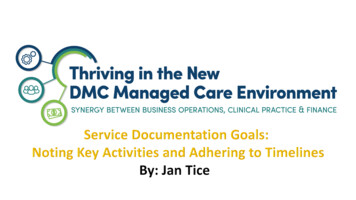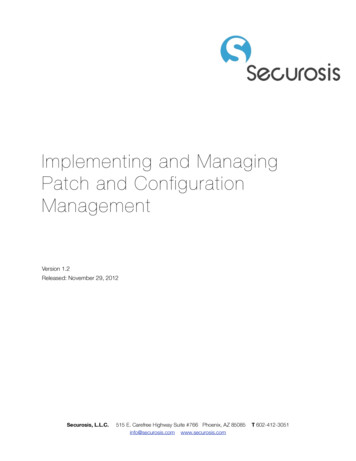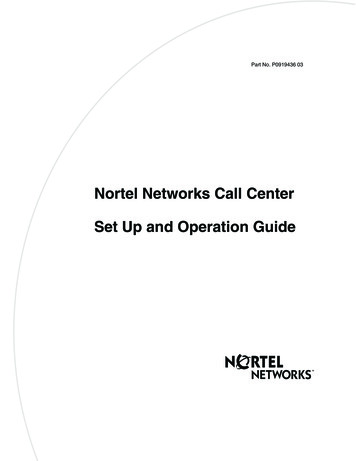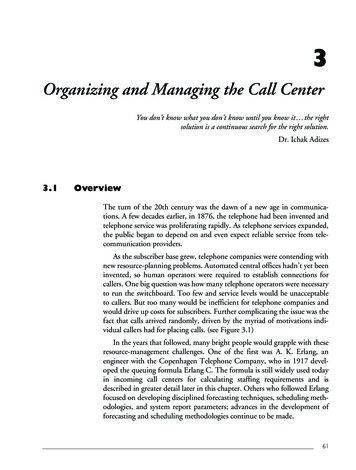
Transcription
3Organizing and Managing the Call CenterYou don’t know what you don’t know until you know it the rightsolution is a continuous search for the right solution.Dr. Ichak Adizes3.1OverviewThe turn of the 20th century was the dawn of a new age in communications. A few decades earlier, in 1876, the telephone had been invented andtelephone service was proliferating rapidly. As telephone services expanded,the public began to depend on and even expect reliable service from telecommunication providers.As the subscriber base grew, telephone companies were contending withnew resource-planning problems. Automated central offices hadn’t yet beeninvented, so human operators were required to establish connections forcallers. One big question was how many telephone operators were necessaryto run the switchboard. Too few and service levels would be unacceptableto callers. But too many would be inefficient for telephone companies andwould drive up costs for subscribers. Further complicating the issue was thefact that calls arrived randomly, driven by the myriad of motivations individual callers had for placing calls. (see Figure 3.1)In the years that followed, many bright people would grapple with theseresource-management challenges. One of the first was A. K. Erlang, anengineer with the Copenhagen Telephone Company, who in 1917 developed the queuing formula Erlang C. The formula is still widely used todayin incoming call centers for calculating staffing requirements and isdescribed in greater detail later in this chapter. Others who followed Erlangfocused on developing disciplined forecasting techniques, scheduling methodologies, and system report parameters; advances in the development offorecasting and scheduling methodologies continue to be made.61
623.1VoicemailFaxserverTelephonenetworkFigure and databasesVRUPredictivedialerTerminaldevicesTypical call center infrastructure.The management challengeManaging a call center operation successfully requires a multitude ofskills—managerial, troubleshooting, negotiating, and patience, not to mention a personality that works well under pressure and is able to handle thedifferent types of CSRs who will work at the facility over time. Some familiarity with computer and communications technologies is an asset as well,although most internal call center facilities should have ready access to technical support for resolving hardware, software, and communications problems. The steady growth in the call center industry over the past 10 yearshas resulted in a requirement for new job-related management skills. As callcenter personnel have developed these skills, the position of call centermanager has evolved and is now a portable, definable position, recognizedfrom company to company and across different sectors of industry.The global growth of call centers as a significant element of customercentered business has led to the employment of a large number of people incall centers, estimated to be between 3 and 4 million, in North Americaalone. From a labor market perspective, the industry is not saturated, sincethe growth of call centers outpaces the supply of employees. Historically,the industry has had a difficult time attracting a steady supply of qualifiedworkers. Turnover in the call center industry is a major problem as well.Turnover rates are significantly higher than those of other industries. Arecent benchmarking study of call centers by the Purdue University Center
3.1Overview63for Customer-Driven Quality found that turnover is an industrywide problem. The survey revealed that inbound centers have an average annual turnover of 26% for full-time reps and 33% for part-timers. Nearly half of thecenters said that part-timers handle 5% or less of their total calls.This book cannot solve the turnover problem, nor can it make moreemployees available to the call center industry. However, in the context ofthe axiom that “good management of human resources means happy, long-termemployees,” the guidelines and experiences of successful call center managers, as presented in this chapter and in Chapter 5 can assist new and existing call centers to manage the human resources that are so essential to theirsuccess.Rising staff costsFaced with the requirement of generating a profit, many businesses confront a major problem: rising staff costs. Over the next few years, management of call/contact center staff will move to the forefront of corporateconcerns because The average call/contact center spends between 60 and 70% of itsannual budget on staff salary. Globally, agent turnover rates average 22%, and approach 50% insome industries. Staff absenteeism is increasing and is as high as 17% in the healthcare industry, 10% in the telecommunications and consumer products markets, and averages 9% across all vertical markets. Over 80% of companies use external advertisements to search foragents and 72% use recruitment agencies, both of which involve significant costs. Call/contact center location clustering is increasing and has causedsevere shortages of qualified staff in places such as Dublin (Ireland),Omaha, Nebraska (United States), New Brunswick (Canada), andAmsterdam (The Netherlands). In most countries with major call/contact center clusters, recruitment is becoming very difficult. There has been a rapid increase in the growth of the call/contact center industry. The growth of CRM and multimedia interaction will require skilledand experienced agents, and training costs will increase accordingly.Chapter 3
643.23.2Management guidelines for a productive call centerManagement guidelines for a productivecall centerCall centers need to tread the thin line between improving service, sales,and revenue on the one hand and controlling costs on the other. When theproper balance is struck by effective management of the call center, theresult will be a company that is more efficient and more productive on alllevels. To achieve these dual objectives, the cost of hiring, training, andmeasuring the performance of CSRs needs to be managed carefully.The significant contribution of the human element to the success orfailure of a call center operation, and the statistics just described, presentcall center managers with the following human resource challenges: Hiring competent, skilled CSRs Establishing competitive salary ranges Motivating and retaining CSRs Measuring CSR performance Maintaining CSR skills through appropriate trainingThis chapter focuses on the management aspects of call centers, includingworkforce management practices and processes, including CSR monitoringand performance measurement, call center structure, outsourcing resources,operator scheduling, and contingency and disaster recovery planning.Chapter 4, “Selecting and Training Call Center Staff,” provides insightinto and more specific guidelines for another human resource aspect of callcenter management—staff selection and training—and the application ofproven management techniques to ensure a productive call center environment and the effective management of the all-important human resource.Workforce management systems (WFM)One of the most important tools available to call center managers is theworkforce management system (WFM). However, despite the wealth of technology available to manage call center operations and the critical nature ofworkforce management, workforce management systems are used in onlyabout 10% of call centers, according to industry sources and surveys conducted over the past few years.The first WFM applications were relatively unsophisticated comparedto current products; however, they significantly reduced the time required
3.2Management guidelines for a productive call center65to do simple agent scheduling. These applications were fed data from theACD but were normally stand-alone solutions with limited or no integration, which meant the call center scheduler did not have a particularly accurate picture of what needed to be done. The WFM system did not improvethe call center managers’ knowledge so much as it assisted them in reachingsimilar conclusions more quickly.Workforce management in the call center has been defined as “the artand science of having the right number of CSRs available at the right time, toanswer an accurately forecasted volume of incoming calls at the desired servicelevel, with quality.” A number of software products are available to accomplish this objective, and their capability to accurately predict call volume andthen staff accordingly is very attractive. More call centers should incorporatethis software tool to make the task easier. The 10% of call centers that douse workforce management software are among the most advanced call center operations, with high call volumes, extensive use of technology, and highproductivity levels. There are reasons why many centers do not use theseproductivity products, however, including the following.CostWFM can be expensive; systems that predict call volume and match staffschedules to that volume can cost between 50,000 and 100,000 or more.High maintenanceThe perception that a fully configured WFM system requires scheduling,feeding data in, going over the data that comes out, and providing full-timesupervision of the system may be true in some cases. When a system is complex, more training is required to run it, especially when scheduling andpredicting are required across multiple sites.Cultural barriersGreater market penetration faces “cultural” barriers, in this case, the cultureof the traditional call center where more emphasis is placed on managingthe call and its flow through the system than on managing the workforce.Limited promotion of WFM product capabilitiesCompanies that develop and supply WFM software have not provided acomplete description of the benefits, perhaps because these vendors do notsee the need, or because they do not have the level of competency or industry experience to appreciate the need.Chapter 3
663.2Management guidelines for a productive call centerComplexityThe disparity between the actual complexity required to develop the bestpossible schedule and the apparent simplicity of creating a schedule is oftennot recognized.Call center managers have a range of options for creating a schedule, froma manual, back-of-the envelope calculation to using formulas in a simplespreadsheet with a special calculator to input the center’s variables to ultimately using a five- or six-figure full-fledged computer program. Achievingthe highest level of workforce productivity does require some powerful software, and it will be expensive.Workforce management systemsfor multimedia centersWFM solutions will become a key CRM-enabling technology in the multimedia call/contact center. It is an application that may provide a solution toboth agent attrition and multimedia staffing. Businesses will be able to provide the right agents to the right customer and to leverage customer segmentation for a superior level of customer service. Without a means ofaccurately forecasting how much human resource will be needed to keepcustomers and agents satisfied while keeping costs to a minimum, businesses could have every sophisticated e-application available but fail toreach an acceptable service level.The cost of running a contact/call center is considerable in most enterprises, and the center traditionally has been viewed as a cost center—a necessary evil. This perception has resulted in keeping expenditures ontechnology, people, and business processes to a minimum. The advent ofthe CRM approach and its impact on call centers, and vice versa, havemeant that leading businesses in sectors such as financial services, retail, andtelecommunications are beginning to view their contact centers as profitgenerators. Revenue growth is encouraged through cross selling and upselling support, and costs are kept low through implementing solutions suchas IVR, predictive dialers, and other technologies that have been developedto streamline call center operations.In the multimedia contact center, as in the traditional call center, theaim of workforce management software is to have the right agents availableto help customers at the right time. A sophisticated yet easy-to-use solution,this software has become one of the most useful tools currently available toa call/contact center manager, from both the customer satisfaction and
3.2Management guidelines for a productive call center67agent retention perspectives. Although WFM is not a total solution, itenables the business to resource the center as it wishes. The key attribute ofsuperior workforce management software is its flexibility, particularly in amultimedia environment. The advent of CRM and multimedia customercontacts means that WFM is destined to play an increasingly importantrole in most major call/contact centers, supporting both the managementof multimedia interactions and also allowing businesses to focus on customers’ needs and resource the center effectively.As previously noted, despite a relatively low profile in the past, interestin workforce management solutions has begun to grow. Leading companiesare learning that there are major savings to be realized with WFM as well asopportunities to increase customer and agent satisfaction in a relativelycost-effective manner. Before WFM became available, call center managersspent days at a time working out agent staffing schedules with only a computer spreadsheet to help. A complex task requiring a great degree of skill toperform, the schedule was prone to error through last-minute changes ofcircumstance, lack of historical data, or plain human mistakes. Even whensuccessfully accomplished, the level of detail and accuracy in the scheduleoften left something to be desired.Advanced WFM to support multimedia and CRMThe primary reason for implementing a new workforce management solution in a call/contact center operation is multimedia contac
odologies, and system report parameters; advances in the development of forecasting and scheduling methodologies continue to be made. 62 3.1 Overview The management challenge Managing a call center operation successfully requires a multitude of skills—managerial, troubleshooting, negotiating, and patience, not to men-tion a personality that works well under pressure and is able to handle the .
